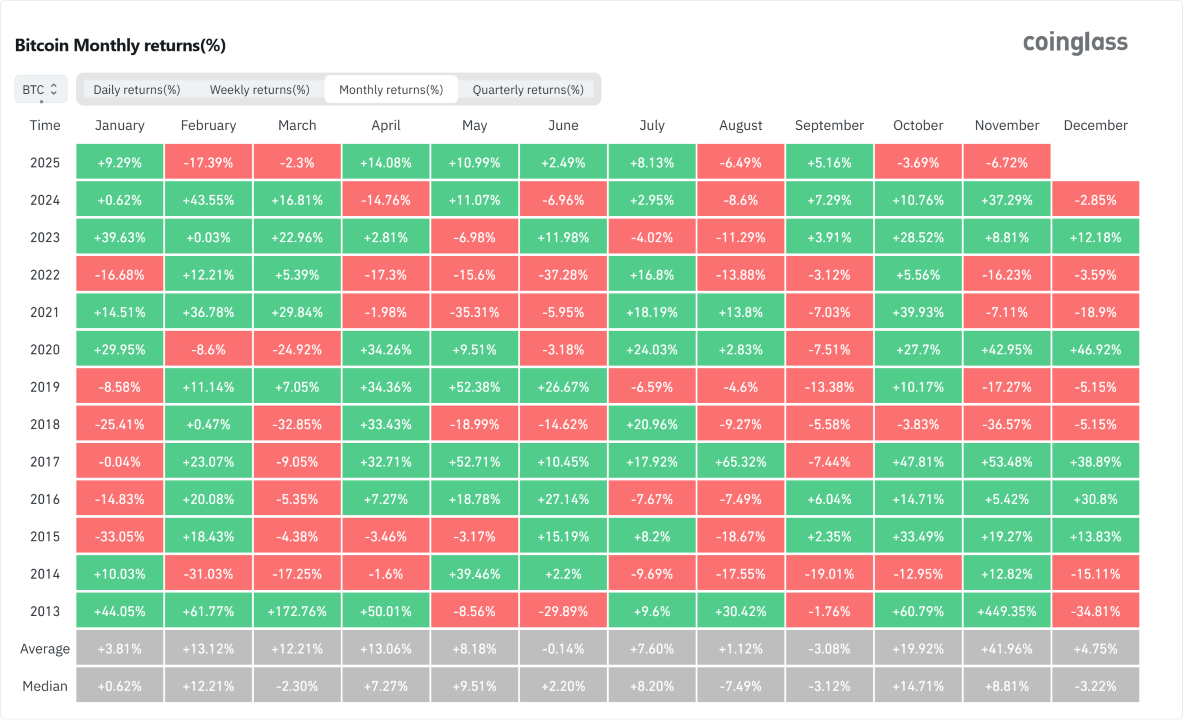November is typically a good month for bitcoin. Data from Coinglass shows positive monthly returns for the cryptocurrency 66% of the time between 2013 and 2024. But this November has been different. BTC is already down 6.72% and counting, thanks to a combination of bad luck, greed, and unfairly high expectations.

( Bitcoin’s historical monthly returns since 2013 / Coinglass)
On Oct. 6, the digital asset peaked at $126K. Bullish traders piled on leverage as calls for a $200K year-end price got louder. Glassnode metrics show that 99.8% of all bitcoin in existence was in a profitable position at the time. “We continue to see BTC rising to around USD 135,000 by end-Q3 and to USD 200,000 by end-Q4,” Standard Chartered Bank projected in a summer note.
But everything changed on October 10 when a clearly agitated Donald Trump lashed out at China, accusing Beijing of underhanded trade tactics and threatening a “massive increase” in tariffs on Chinese goods. The result was the greatest liquidation event in crypto history. More than $19 billion in margin was liquidated, and bitcoin tumbled below $110K in the ensuing chaos. BTC’s price sputtered, bobbing up and down sporadically, but it never fully recovered.
Then commotion in stocks caused by an alleged AI bubble, labor market concerns, and a prolonged U.S. Federal government shutdown applied even more downward pressure on bitcoin, sending it below $100K for the first time since June 2025. The digital asset is now trading sideways, and pundits are furiously debating future price action.
One question being asked is whether $100K is the new norm. Most analysts don’t think so. Predictions have been revised downward, but most experts still see a rally in bitcoin’s future. “As a result of this market performance and other factors, we are revising our bullish bitcoin target from $185,000 to $120,000,” said Alex Thorn, head of firmwide research at Galaxy, in a Wednesday note to clients.
Coindesk reported on Thursday that JPMorgan is predicting a BTC price “as high as $170,000 within the next six to 12 months” based on a quantitative comparison to gold. “The message from recent stabilization is that deleveraging in perpetual futures is likely behind us,” JP Morgan said in the report referenced by Coindesk’s article. In other words, October’s liquidation event was likely an anomaly, and soon the cryptocurrency will be back on an upward trajectory.
Bitcoin edged up 1.2% on Friday afternoon, trading at $102,879.05 at the time of reporting, but weekly performance was still down 6.24%, Coinmarketcap data shows. The digital asset fluctuated between $99,257.06 and $102,912.61.

( Bitcoin price / Trading View)
Twenty-four-hour trading volume jumped 47.42% to $91.15 billion and market capitalization inched up to $2.05 trillion. Meanwhile, bitcoin dominance fell significantly, shedding 1.2% to reach 59.80%.

( BTC dominance / Trading View)
Total value of bitcoin futures open interest climbed 5% to $71.30 billion, according to Coinglass. Liquidations finally eased on Friday, dropping down to $148.37 million over the past 24 hours. Long and short losses approached a more even distribution, but longs still lost more, with $84.86 million wiped out. Short sellers saw a slightly smaller $63.52 million in liquidated margin.
- Why is bitcoin stuck around $100K?
A mix of global uncertainty, AI stock turmoil, and the prolonged U.S. government shutdown has kept prices flat. - What caused the earlier crash from $126K?
Trump’s tariff threats against China on October 10 triggered $19 billion in crypto liquidations, erasing months of gains. - Are analysts still bullish on bitcoin?
Galaxy cut its target to $120K, but JPMorgan still sees BTC reaching as high as $170K within a year. - Is $100K the new normal?
Most experts say no, viewing the sideways trend as a pause before the next rally, once macro pressures ease.
免责声明:本文章仅代表作者个人观点,不代表本平台的立场和观点。本文章仅供信息分享,不构成对任何人的任何投资建议。用户与作者之间的任何争议,与本平台无关。如网页中刊载的文章或图片涉及侵权,请提供相关的权利证明和身份证明发送邮件到support@aicoin.com,本平台相关工作人员将会进行核查。



